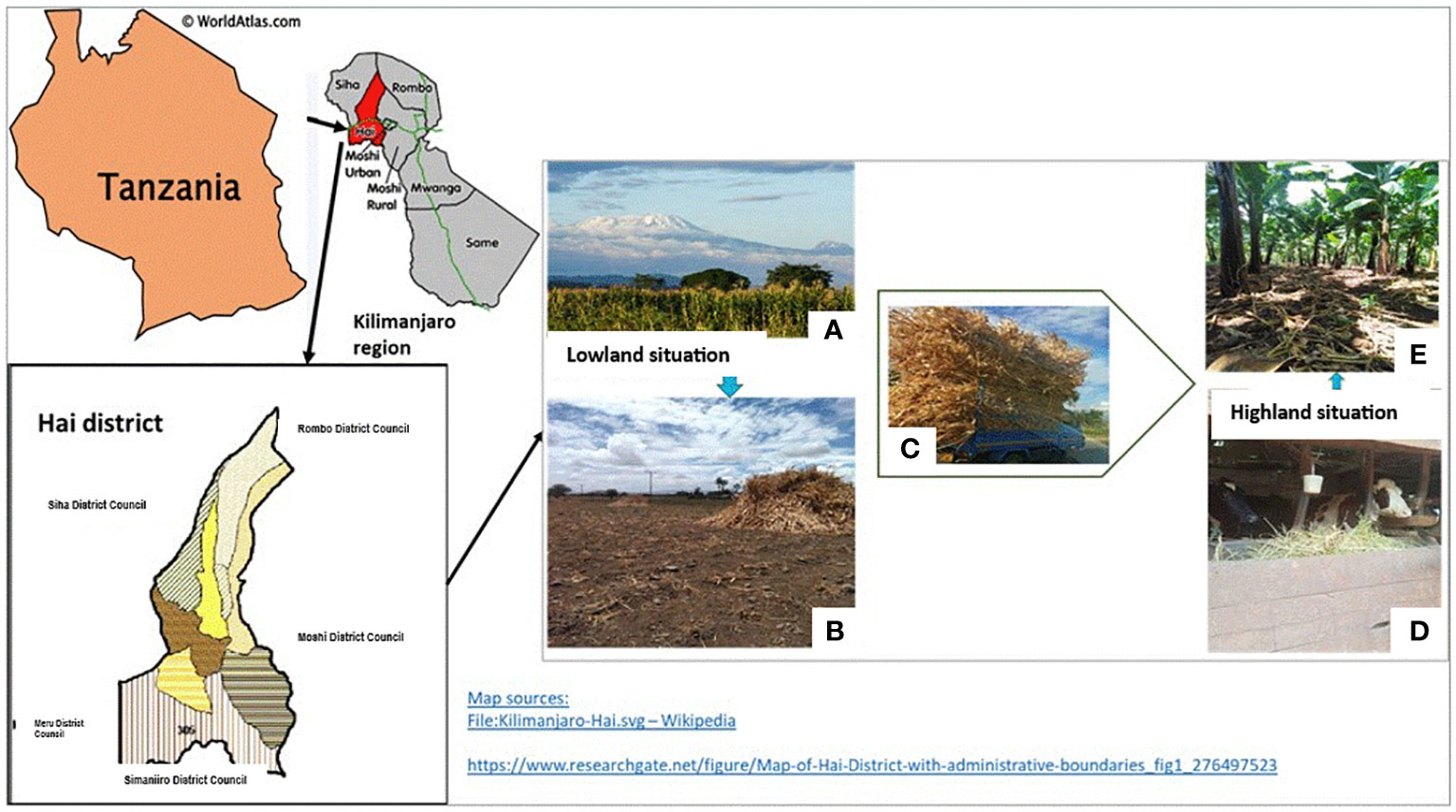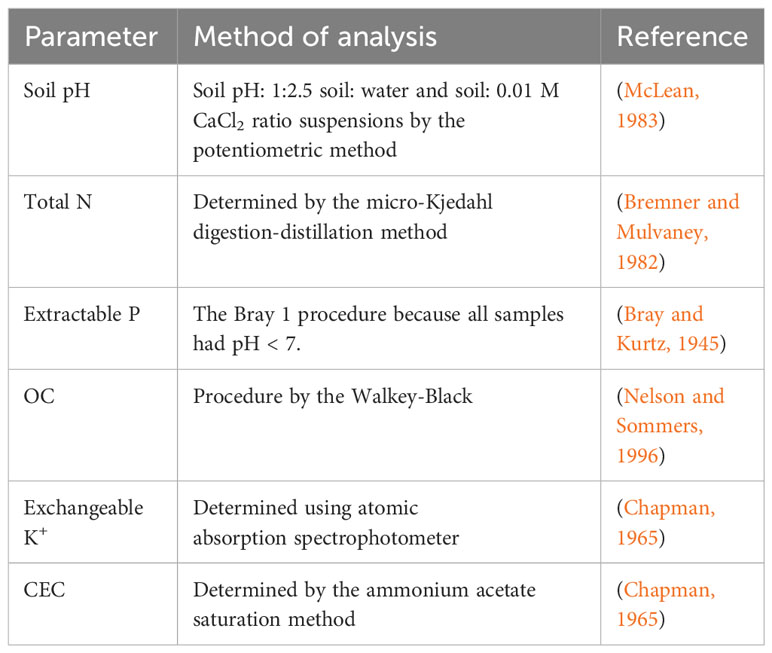Farming systems and soil fertility management practices in smallholdings on the southern slopes of Mount Kilimanjaro, Tanzania
[ad_1]
1 Introduction
Low nutrient inputs, whether from organic or chemical fertilizers, limit agricultural lands’ ability to produce optimal yield (Amuri et al., 2017; Mesfin et al., 2021). In the Kilimanjaro region of Tanzania, the slopes of Mount Kilimanjaro are the most important areas both in terms of socio-economic development and ecological succession (URT, 2017; Kimaro & Bogner, 2019). Favorable weather conditions (good rainfall quantity and distribution) and fertile soil play an important role in crop production, and more than three-quarters of the livelihood population of the Kilimanjaro region depends on the resources provided by Mt. Kilimanjaro (Misana et al., 2012; URT, 2017). For more than a century, the majority of farming activities were concentrated in the highlands zone (between 900 and 1800 m above sea level) (URT, 2017). Banana (Musa spp.) is a dominant crop in the farming systems on the highland zone of Kilimanjaro Mountain (De Bauw et al., 2016), estimated to cover approximately 1000 km2, which is more than two thirds of the cultivated area of the extended mountain forest belt (Ichinose et al., 2019). Other crops include coffee, maize, beans, and fodder trees integrated with livestock (goats and dairy cattle) kept in a zero-grazing system (Ichinose et al., 2019).
Smallholder farmers in the highland slopes of Kilimanjaro Mountain have been involved in cultivating the land for over a century and established a very intensive system of land use locally called Kihamba system (tree-banana-coffee system) (Misana et al., 2012); which resembles Kibanja system of Bukoba- northwest of Tanzania (Baijukya et al., 2005). The Kihamba system is multiple-layered, i.e., tree-banana-coffee-grass, which allows nutrient recycling within the system (Misana et al., 2012). The intensive multiple cropping together with livestock keeping has stabilized the productivity of the system by providing not only soil cover, which ultimately conserves the soil from erosion, but also the nutrients cycling that has ensured nutrients use efficiently (Ichinose et al., 2019). People in the region are subject to customary laws based on patriarchal traditions that rely on the concept of “keeping the name on the land” (Maghimbi, 2007). This implies that land is inherited by the male bloodline (Misana et al., 2012), which eventually leads to the land being fragmented into small pieces, resulting in the current average of 0.4 ha per household (URT, 2017). Consequently, this practice has increased pressure on available agricultural lands and resources and compelled farmers to look for new farming areas in the lowlands to supplement food and fodder (Maghimbi, 2007).
In the lowlands, farmers primarily cultivate maize and beans, and during the harvest, both crop grains and residues are transferred to the highlands to make up the difference (Plate 1). However, this practice has led to huge land degradation in the lowlands and posed many challenges to people’s livelihoods, among them a decline in soil fertility, which in turn resulted in low crop yields in the lowlands and raised concerns about its sustainability (Kangalawe et al., 2014; Mbonile et al., 2003; Misana, 2019; Misana et al., 2012). Although animals are fed with grasses, banana leaves, and other vegetation, finding enough fodder for livestock keeping in the highlands is a big challenge; thus, farmers are forced to collect all the maize and bean residues from the lowlands to supplement animal feeds in the highlands (De Bauw et al., 2016; Plate 1). These farming practices have been around for decades; however, the importance of these residual transfers is poorly documented; neither their effectiveness nor their sustainability are evaluated.
Smallholder farmers in Tanzania account for more than 70% of the country’s agricultural output. Farming practices in smallholdings in Sub-Saharan Africa (SSA), Tanzanian included, are usually associated with little to no soil nutrient replenishment and the total removal of crop residues, which trigger the impact of soil degradation (Laekemariam et al., 2018; Van Loon et al., 2018). Consequently, crop yields in this region are too low to meet the yield potential. Among other reasons for the lowest crop production in the region, low soil fertility caused by continuous farming practices involving total removal of crop residues has been suggested (Pržulj et al., 2022). Since crop residue is preserving soil organic carbon (OC) as well as the physical and microbiological characteristics of the soil, research has shown that removing it from cropland has a negative influence on soil quality (Pržulj et al., 2022). Furthermore, there is a significant amount of nutrients in crop residues that can be regenerated annually. Research indicates that the organic residues left over from agricultural land residues consist up to 70% of K and might contribute between 25 and 100 million tons of recycled nitrogen annually to the world economy (Laekemariam et al., 2018; Pržulj et al., 2022).
Losses of soil nutrients have been associated by several factors including soil erosion, leaching, and nitrification however, studies of the soil nutrient budget have proven that crop harvest is the major nutrient export from smallholder farming systems (Adamtey et al., 2016; Mhoro et al., 2023). In the Meru area of Arusha, Tanzania, where similar practices are used as in the Kilimanjaro region, Kaihura et al. (2001) estimated nutrients removal from the lower maize fields were up to 57.6-12.5-55.5 kg of N-P-K per hectare (ha) per season. A similar situation was also observed by Baijukya et al. (2005) in Bukoba district, Tanzania, where zero-grazed dairy cattle in the banana-coffee farming systems were fed with grasses and maize residues collected from other fields, resulting in nutrient depletion of up to 21-2-15 kg N-P-K ha-1 on those fields. Research evidence suggests that continuous cropping with low nutrients input can reduce soil fertility, resulting in poor yields and environmental degradation (De Koning et al., 1997; Koning & Smaling, 2005; Bahilu et al., 2016). Observing a similar scenario unfold in the Kilimanjaro region, one can imagine that the sustainability of lowland fields is jeopardized unless significant effort is put into nutrient replenishment in those areas. As a result, the goals of this study were to: (i) examine socio-demographics and their impact on farming practices along the slope of Mt. Kilimanjaro in Hai district; and (ii) compare soil nutrient contents in the banana-based system in the highlands and the maize-based system in the lowlands.
2 Materials and methods
2.1 Study site
Hai district is one of the seven districts in the Kilimanjaro Region, Tanzania. It is located between latitudes of 3° 09’ 60.00” S and 37° 09’ 60.00” E (URT, 2017). The area has high potential for crops production, with an annual rainfall ranging from 700 mm in the lower zone to 2000 mm in the upper zone and a mean annual temperature of 23°C (Munishi et al., 2015; URT, 2017). The district experiences bimodal rainfalls, with the long rainy season starting in March and ending in June, while November and December are mainly characterized by the short rainy season (Lema et al., 2014). For demographic data collection, the area was divided into two transects: the banana farming zone (highlands, >1000 m.a.s.l) and the maize farming zone (lowlands, <999 m.a.s.l). On the other hand, for soil nutrient analysis, the highland was further subdivided into two sub-zones: the upper zone (>1400 m.a.s.l) and the mid zone (between 1000 and 1400 m.a.s.l) to account for the effects of altitude, climate, and soils (Mathew et al., 2016). The annual rainfall usually ranges from 400 to 900 mm in the lower zone, 1000 to 1200 mm in the mid zone, and 1200 to 2000 mm in the upper zone (Soini, 2006; URT, 2017). The study was conducted in four geographically scattered wards namely; Masama Mashariki and Machame Mashariki [representing the upper zone and Masama Rondugai and Narumu representing the mid zone of the slope of Mt. Kilimanjaro (Figure 1). Selected farmers from the highlands upper and mid zones (banana farming) were used to determine the lowland maize-based fields.
Figure 1 A summary of farming systems on the southern slopes of Mount Kilimanjaro in Hai district, Tanzania: (A) maize-based fields in the lowlands; (B) harvested maize stover and cobs; (C) transportation of harvested maize stover and cobs to the highlands; (D) maize stover used to feed livestock kept under a zero-grazing system; (E) livestock feedlots and manure are used to manage soil fertility in the Kihamba system.
2.2 Criteria for respondent selection and inclusion
The purposive sampling technique was used to recruit respondents for this study. To do this, three local ward agriculture extension staff and four ward leaders with experience in the existing farming systems were chosen to guide respondents’ identification and recruitment. Farmers were randomly selected based on the following criteria: at least three years of residence in the respective ward; one farmer per household; involvement in farming activities for at least two seasons; and households with crop fields on either the highlands (upper and mid zones) or lowlands of the slopes of Mt. Kilimanjaro, or both (highlands and lowlands). Before administering the questionnaire, ward extension staffs and ward leaders assisted farmers’ household visits, during which the interviewer had the opportunity to crosscheck inclusion criteria adherence. A multistage sampling design was used, and a total of 60 farmers were selected and interviewed using a semi-structured, open-ended questionnaire to identify farming practices in the study area. The questionnaire primarily gathered information on socio-demographics (gender and age), farming systems (cropping systems and livestock keeping), extension services, fertilizer use, and soil fertility management practices and challenges.
2.3 Soil sampling and analysis
For soil sampling, fields in the same location (highlands or lowlands) were supposed to be at least 0.5 km apart. This was done to account for nutrient gradients between at least two vertically adjacent farms. Soil samples were taken from 40 farms: 20 farms from the banana-based farming zone, i.e., 10 farms from the high zone, 10 farms from the mid zone, and 20 from the maize-based farming zone. Depending on the farm size and field terrain, 1–3 composite soil samples were collected on each farm (Figure 2). To make one composite sample, sub-samples were collected from 10 to 15 points within a given field. A total of 96 soil samples were collected. The soil samples were air dried, ground, and sieved through a 2 mm mesh to obtain fine earth for nutrient analysis. Laboratory soil analysis for pH, total nitrogen (N), organic carbon (OC), extractable phosphorus (P), available potassium (K) and cation exchange capacity (CEC) was conducted at the Soil Science Laboratory at the Sokoine University of Agriculture (SUA). A summary of soil analysis procedure is presented in Table 1 below.
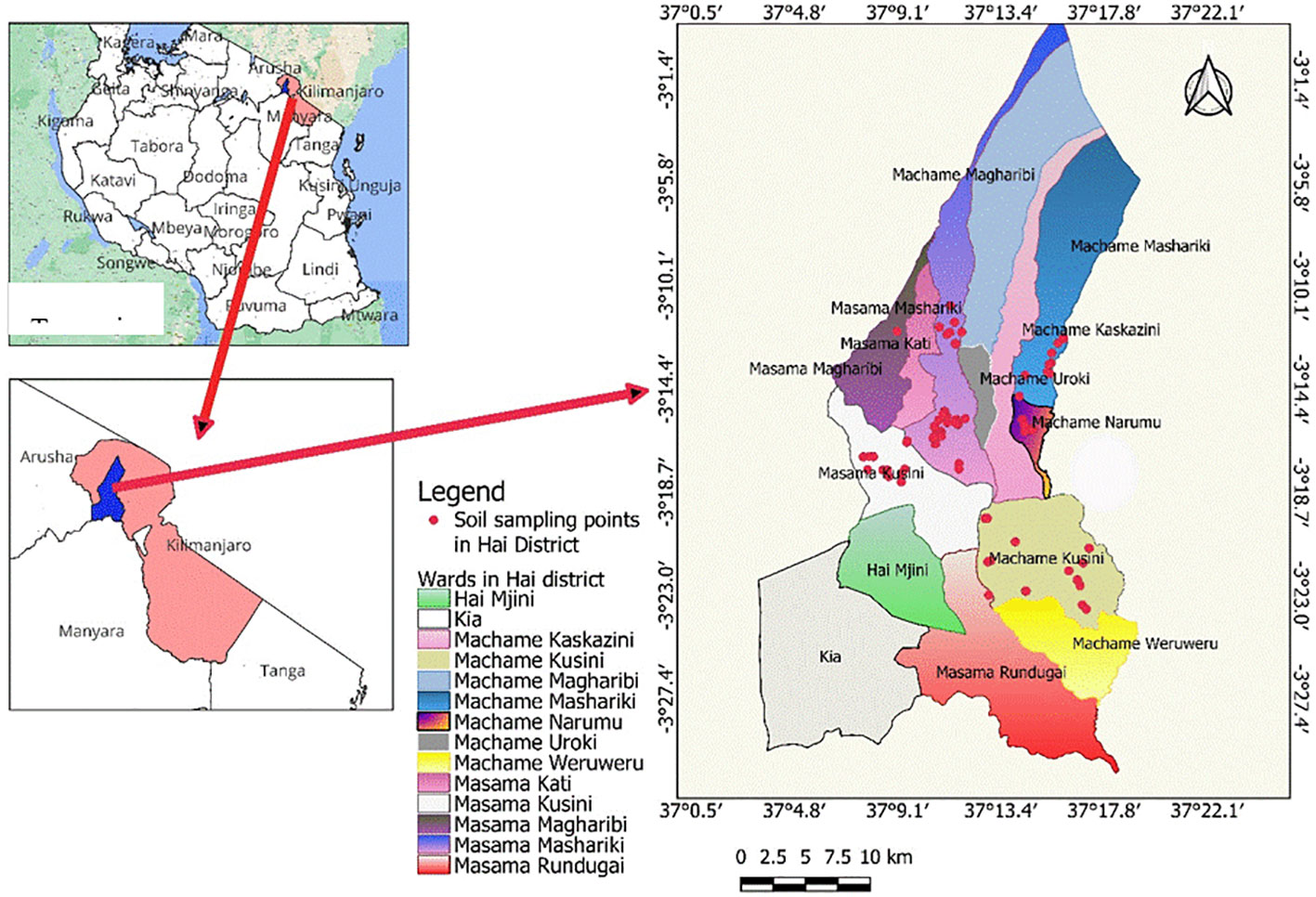
Figure 2 A location map of the Hai district, Kilimanjaro region, Tanzania, indicating soil sampling points.
2.4 Statistical analysis
Socio- demographics data were summarized and descriptive statistics (means, standard deviation, and percentages) were calculated using the Statistical Package for Social Sciences (SPSS) version 23. The percentages of gender (female or male), age (youth or elder) farm locations, access to extension services, crops grown, and livestock were summarized using tables and figures. Chi-square was used for statistical comparisons of socio-demographic data to identify significant differences between variables, and one-way analysis of variance (ANOVA) was used to assess significant differences in soil chemical properties across altitudinal gradient (upper, mid and lower zones) of the slope of Mt. Kilimanjaro using STATISTICA software. The distribution of soil nutrients along the slope of Mt. Kilimanjaro was depicted using box and whisker plots. Pearson’s correlation (Lauderdale, 2005) was used to observe the relationships between soil pH and nutrient concentrations and their interactions.
3 Results
3.1 General demographic characteristics of study population
Findings from the study area showed that the majority of respondents were males (91.6%) (Table 2). However, in terms of land ownership, 80% of males owned farms in the highlands, while only 20% of females owned farms in the highlands. In addition, the majority of men (96.1%) had farms on both sites (highlands and lowlands). Moreover, land ownership in the lowlands was 50% for both males and females. The data also found that land ownership varied according to age. For example, in the highland areas, the elderly (>60 years) were the largest group (60%) in terms of land ownership, while 50% of the age group ranging from 41 to 50 years old reported owning land in the lowland areas. In general, the elderly group had high average (42.7%) in terms of land ownership while only 8.6% of youth owned land though not significantly at p = 0.60 (Table 2). The respondents in the study area were smallholder farmers, with the majority (48.0%) of participants having a farm size ranging between 0.4 -0.8 ha for an average of 0.6 ha (Table 2).
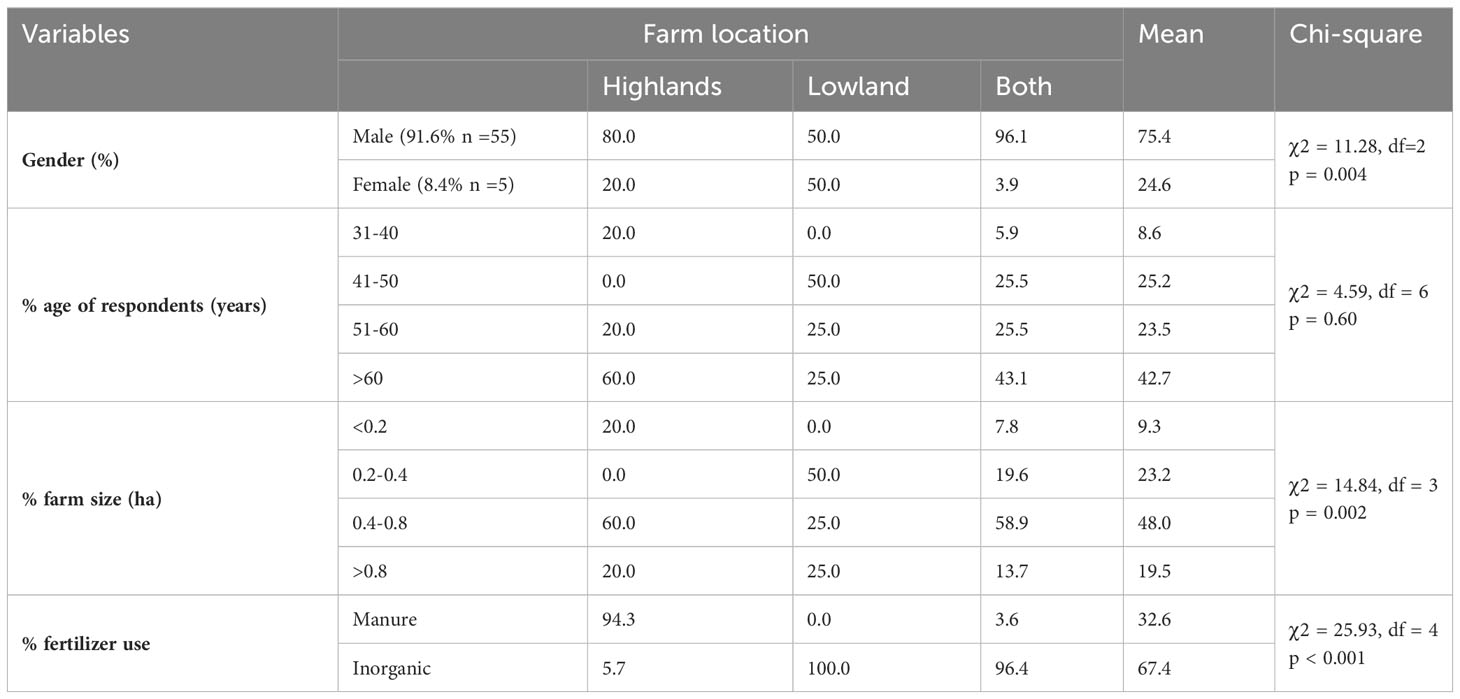
Table 2 Social demographic characteristics of the surveyed population in Hai district, on the southern slopes of Mt. Kilimanjaro in the Kilimanjaro region, northern Tanzania.
3.2 Farming characteristics in the study area
3.2.1 Crop production in the study area
All participants grow bananas as their major crop in highland areas. However, 83.9% of farmers intercropped banana with coffee, while a few intercropped vegetables, maize, beans, vanila, and yams, as illustrated in Figure 3A below. On the other hand, maize is the dominant crop in the lowland (100%), grown in association mainly with common beans (94.8%) and sunflower (56.9%). Other crops like sesame and tomato were also reported to be grown by a few smallholder farmers (Figure 3B). In order to increase crop production, smallholder farmers use improved varieties of banana in the highlands and maize in the lowlands. Furthermore, land preparation in the highlands was done by hand, while tractors were used in the lowlands.
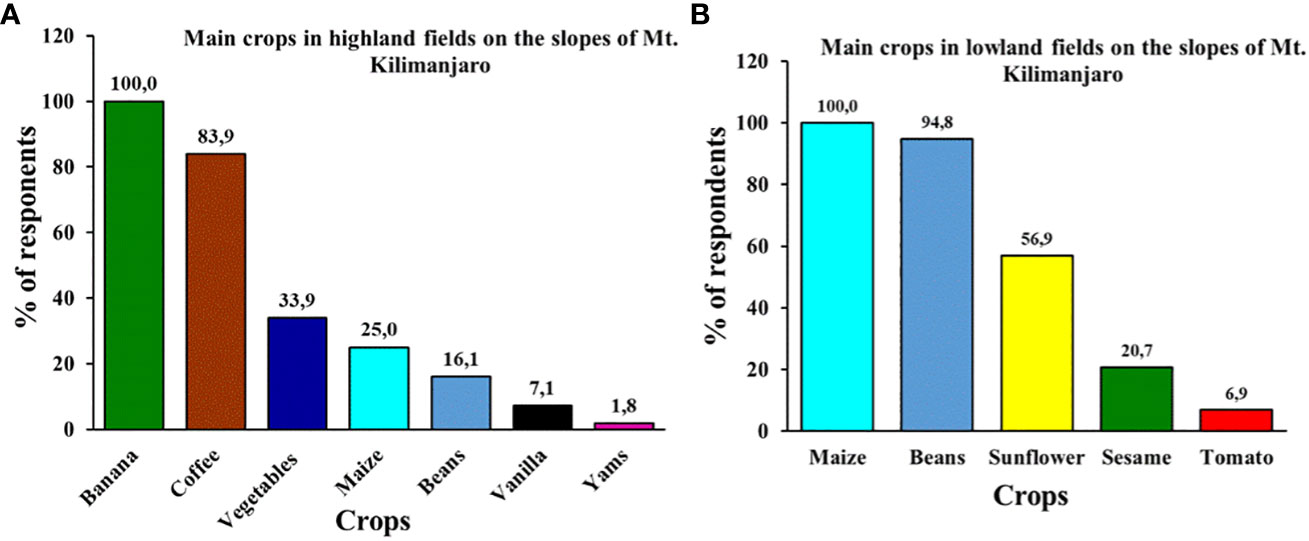
Figure 3 Crops grown in Hai District, along the southern slopes of Mt. Kilimanjaro, Tanzania: (A) main crops grown in the highlands and (B) main crops grown in the lowlands.
3.2.2 Livestock and animal manure production
At least each surveyed household kept one or more livestock (Figure 4A). However, the most reported livestock were cattle (84.7%) and poultry (83.1%). Other livestock, like goats and sheep, were reported to be included in some few households. The amount of manure collected varied from one household to another depending on the number of animals kept (Figure 4B). The majority (31.7%) of respondents reported collecting more than 20 kg of wet animal manure per day (Figure 4B). Nevertheless, the majority (56.6%) of respondents reported to directly toss the collected manure to the fields (home garden fields), while 31.7% of participants reported to store manure in an open space, and only 11.7% store it under the shade (Figure 4C). During the informal discussion, smallholder farmers reported that the livestock are kept in zero-grazing systems and fed with crop residues from banana home gardens, maize stover gathered from the lowlands, and grasses collected from forest reserves in the highlands and swampy areas in the lowlands.
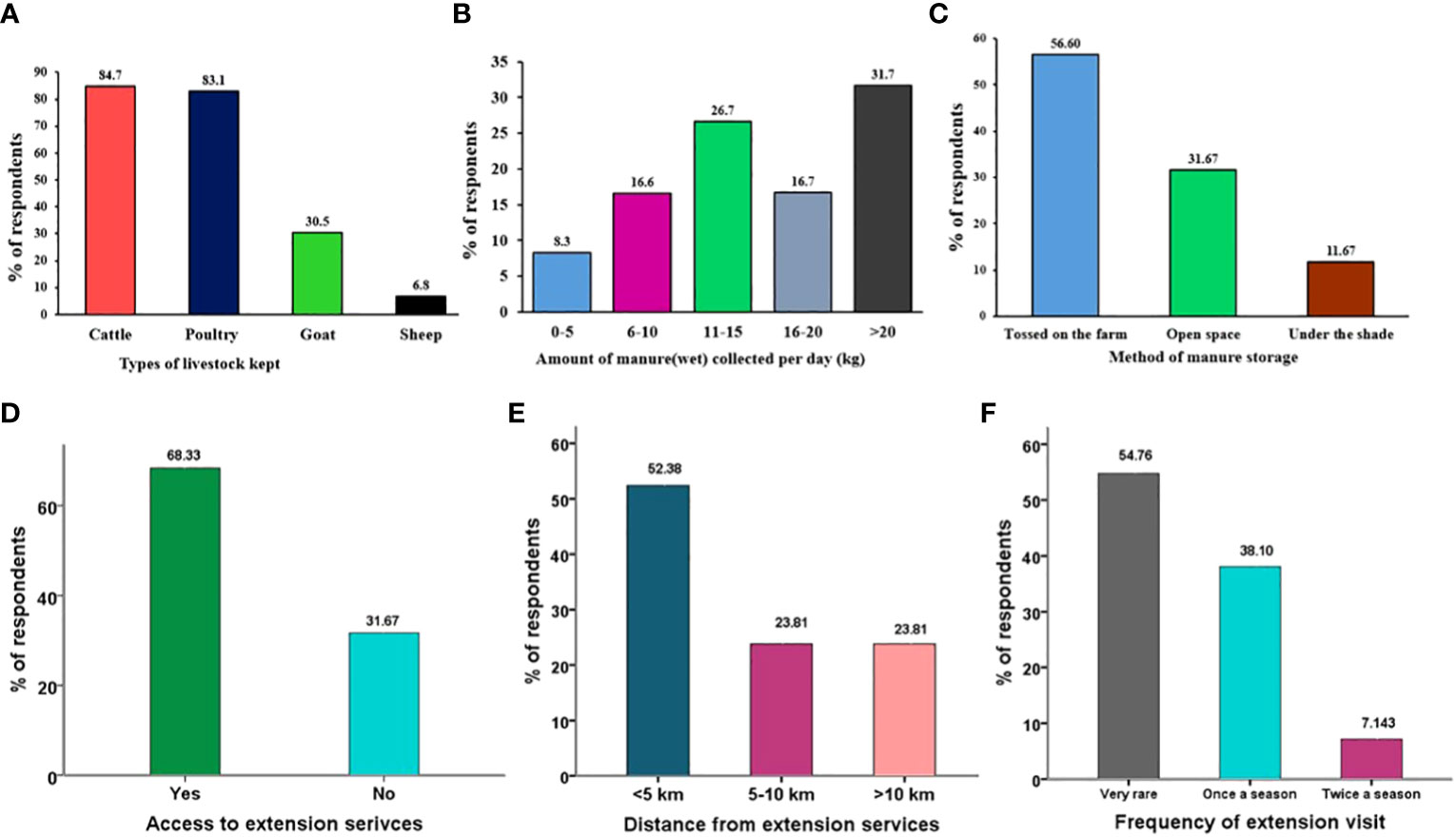
Figure 4 Smallholder characteristics indicating: (A) types of livestock kept; (B) amount of wet manure collected per day; (C) methods of manure storage; (D) access to extension service; (E) distance from extension service; and (F) frequency of extension visits in Hai district, southern slope of Mt. Kilimanjaro, Tanzania.
3.2.3 Extension services
Figure 4D shows that the majority of participants (68.3%) had access to extension services. Less than five kilometers was the most frequently reported distance from extension services (52.4%). On the other hand, 23.8% of respondents reported having extension services between 5 and 10 kilometers and more over 10 kilometers (Figure 4E). For the majority of respondents (54.8%), the number of extension visits was extremely uncommon; 38.1% reported having one visit per season, and just 7.1% reported having two visits per season (Figure 4F).
3.3 Soil management practices and challenges in the study area
3.3.1 Fertilizer use
Both animal manure and inorganic fertilizers were used to replenish soil nutrients in the study area (Table 2). However, the majority (94.3%) of respondents reported using manure in the banana-based system (highland zones) as soil nutrient supplementation on their farms, whereas only 5.7% of respondents claimed to use inorganic fertilizers in the banana fields. In the maize-based system of the lowlands, on the other hand, 100% of respondents supplemented nutrients in their crops with inorganic fertilizers, particularly urea and calcium ammonium nitrate (CAN) (Table 2).
3.3.2 Challenges facing smallholder farmers in soil fertility management
Participants reported various challenges in soil fertility management based on farming practices in the area. Figure 5 depicts the soil fertility constraints in the highlands and lowland farming systems on the southern slopes of Mt. Kilimanjaro. The most frequently mentioned challenges in highlands farming systems were the shortage of animal manure (63.3%), low extension services (50.8%), and high cost of inorganic fertilizers (40%) (Figure 5). In contrast to the lowland area, where high costs of fertilizer (79%), shortages of manure (45.6%), soil erosion (43.9%), and low extension services (43.9%) were the main constraints for soil fertility management in the area (Figure 5).
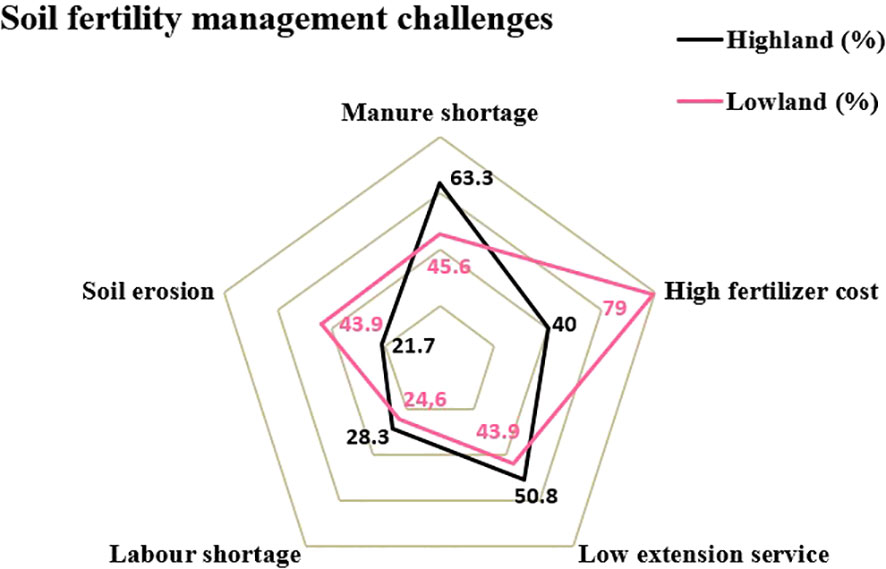
Figure 5 Challenges facing smallholder farmers in soil fertility management on the southern slope of Mt. Kilimanjaro Hai district, Tanzania.
3.4 Soil properties of the study site
The result revealed that the nutrient contents across the slope gradient on the southern slopes of Mt. Kilimanjaro differed significantly (p <0.001) (Table 3). The mid-zone soil pH was significantly (p<0.001) higher (6.58) than the upper and lower zones. However, the pH in the upper zone was much lower (5.54) (Table 3). The total N was significantly (p< 0.001) higher (0.30%) in the midland zone compared to the highland (0.23%) and lowland (0.14%) zones (Table 3). Organic carbon levels did not differ significantly (p > 0.05) between the highland and midland zones, but were significantly (p <0.001) higher in the highland (2.78%) and midland (2.89%) zones compared to the lowland zone (1.23%) (Table 3). Extractable P and CEC were significantly (p <0.00) higher in the mid-zone, at 34.86 mg kg-1 and 14.30 cmol (+) kg-1, respectively, than in the high-zone, at 8.01 mg kg-1 and 8.65 cmol (+) kg-1, and in the lowland zone, at 11.90 mg kg-1 and 9.58 cmol (+) kg-1, respectively (Table 3). Furthermore, K+ was significantly higher [0.93 cmol (+) kg-1] in the lowlands compared with the highlands [0.36 cmol (+) kg-1] and midlands [0.58 cmol (+) kg-1] (Table 3).
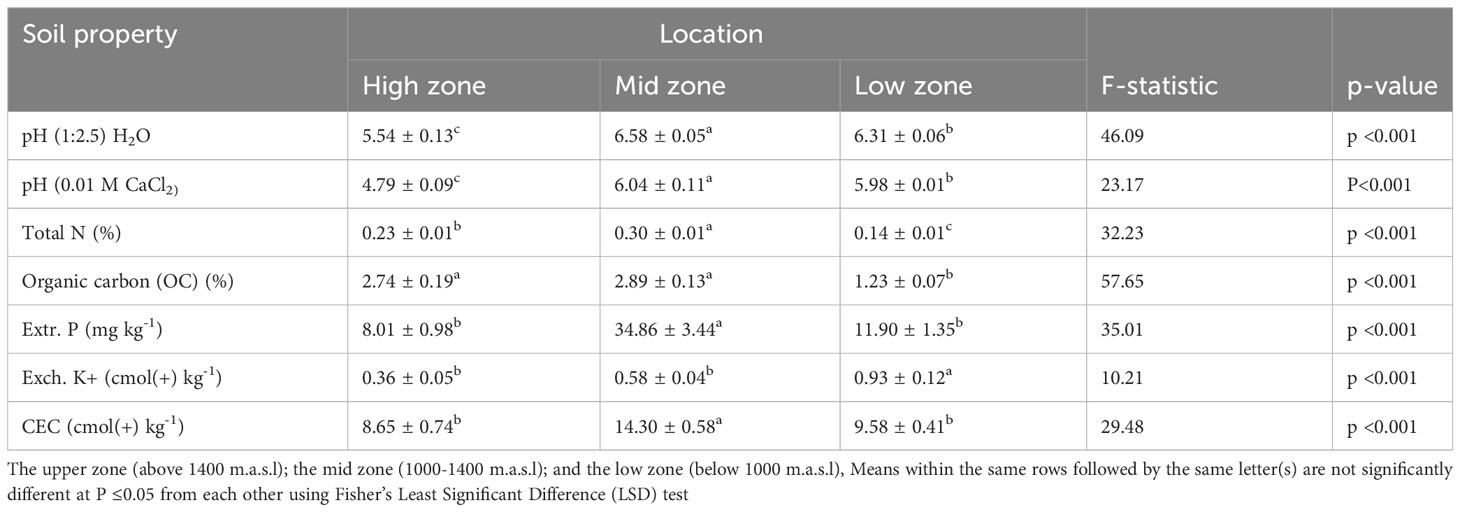
Table 3 Selected soil chemical properties on the southern slope of Mt. Kilimanjaro, Hai district, Tanzania.
3.5 Correlation analysis of soil nutrients in the study area
Table 4 shows the correlation matrix of relationships between soil pH and soil nutrients in the study area. The result indicates that the soil pH exhibited positive and significant associations with CEC and extractable P (r = 0.816, p = 0.01 for CEC; r = 0.563, p = 0.01 for extractable P) in the highland zone. However, in the midland zone, the soil pH showed a positive and significant (r = 0.422, p = 0.05; r = 0.365, p = 0.05) relationship with K+1 and CEC, respectively (Table 4). In the lowland zone, the soil pH was negatively and significantly (r = -0.355, p = 0.05) correlated with total N. Furthermore, the soil pH showed a negative but not significant relationship with OC in all three zones (Table 4). Both positive and negative correlations among soil nutrients were observed across all studied zones, as indicated in Table 4. Total N exhibited a positive and significant (r = 0.380, p = 0.05; r = 0.479, p = 0.01) association with OC in the mid- and lowland zones, respectively. However, in the highland zone, the total N showed a negative but not significant (r = -0.225) relationship with OC. The soil OC was negatively and significantly (r = -0.442, p = 0.05; r = -0.418, p = 0.05) correlated with P and CEC, respectively, in the highland zone, positively correlated (r = 0.342, p = 0.05) with P in the midland zone, and positively associated (r = 0.428, p = 0.05) with CEC in the lowland zone (Table 4). A positive and significant relationship was observed between P with K and CEC (r = 481, p = 0.05; r = 0.661, p = 0.01), respectively, in the high- and midland zones, while a weakly negative association was observed between P with K and CEC in the lowland zone. Exchangeable K exhibited a positive and significant correlation (r = 0.5484, p = 0.05; r = 0.419, p = 0.05; r = 0.508, p = 0.01) with CEC in upper, mid, and lower zones, respectively (Table 4).
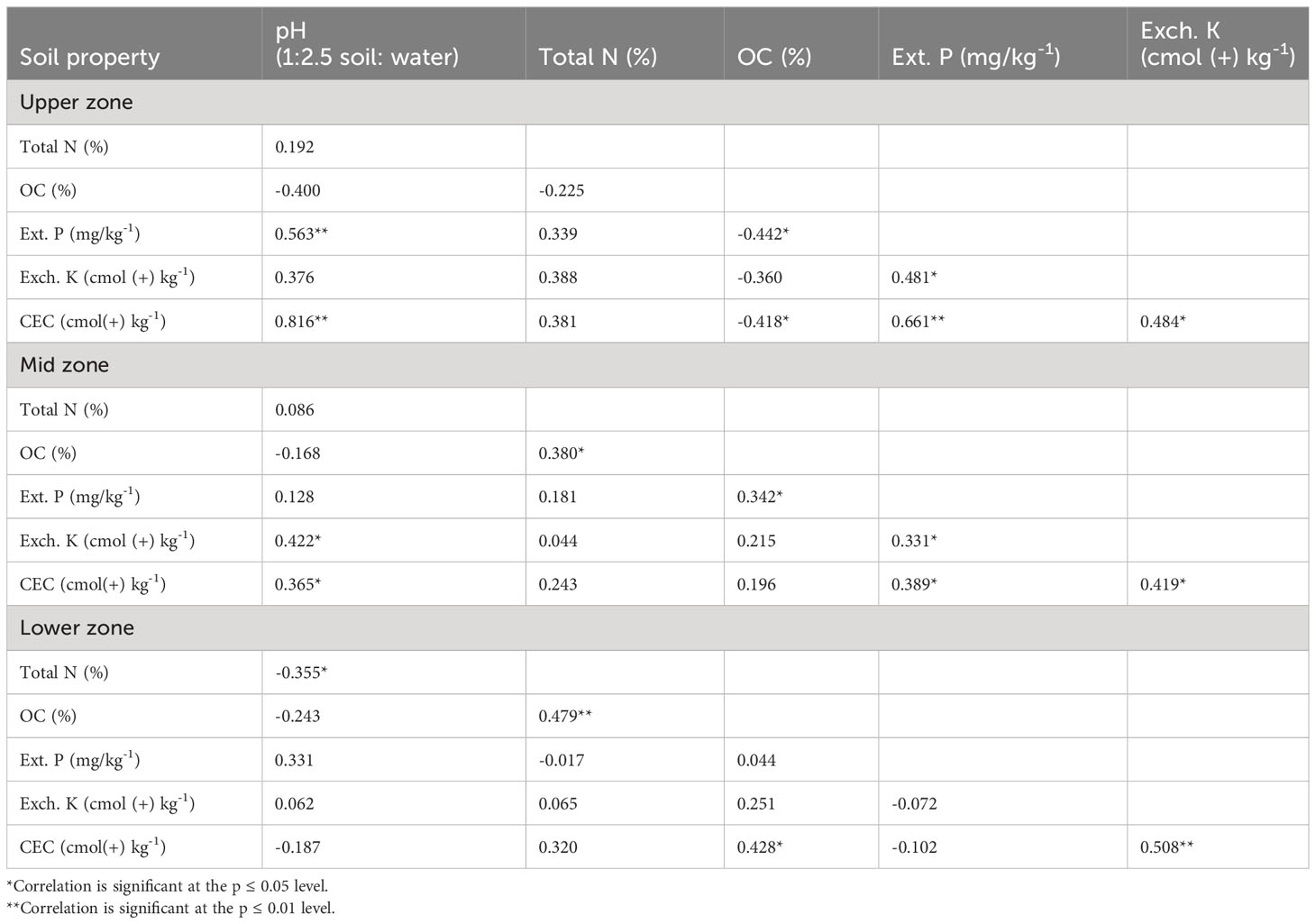
Table 4 Correlation matrix among soil properties on the southern slopes of Mount Kilimanjaro in Hai district, Tanzania.
3.6 Variation of soil nutrient along the slope
The variation in soil nutrients within and between locations is depicted in Figure 6. The mid and lower zones showed narrow pH variations of 5.9–6.9 and 6-7.2, respectively, with the majority (50%) of the soil samples concentrated between 6.4–6.7 and 6.1–6.5, in that order. The upper zone had a broader pH variation of 4.5–6.4, with 50% of it being in the range of 5.1–6.1. Most of the soil samples (50%) had a total nitrogen content ranging from 0.2–0.27%, 0.26-0.36, and 0.1–0.2 in the upper, mid, and lower zones, respectively. With a narrower range of 1.04–1.53% in the lower zone, 50% of the samples in the upper and mid zones exhibited greater OC ranges of 2.08–3.33% and 2.45–3.42%, respectively. The ranges of extractable P varied widely between locations. The majority (50%) of soil samples in the upper and lower zones had narrow ranges of 3.6–12 mg kg-1 and 3.8–18.7 mg kg-1, respectively; however, in the mid zone, most of the soil samples had extractable P ranges of 16.85–48 mg kg-1. The majority (50%) of soil samples in the upper and mid zones had a narrow range of 0.18–0.41 cmol(+) kg1 and 0.41-68 cmol(+) kg-1 K, respectively, while the lower zone had a wider range of 0.43–1.32 cmol(+) kg-1 K. Fifty percent of soil samples in the upper, mid, and lower zones had the CEC range of 6.45–11.7, 11.5–16.35, and 7.5–11.65 cmol (+) kg-1, in that order.
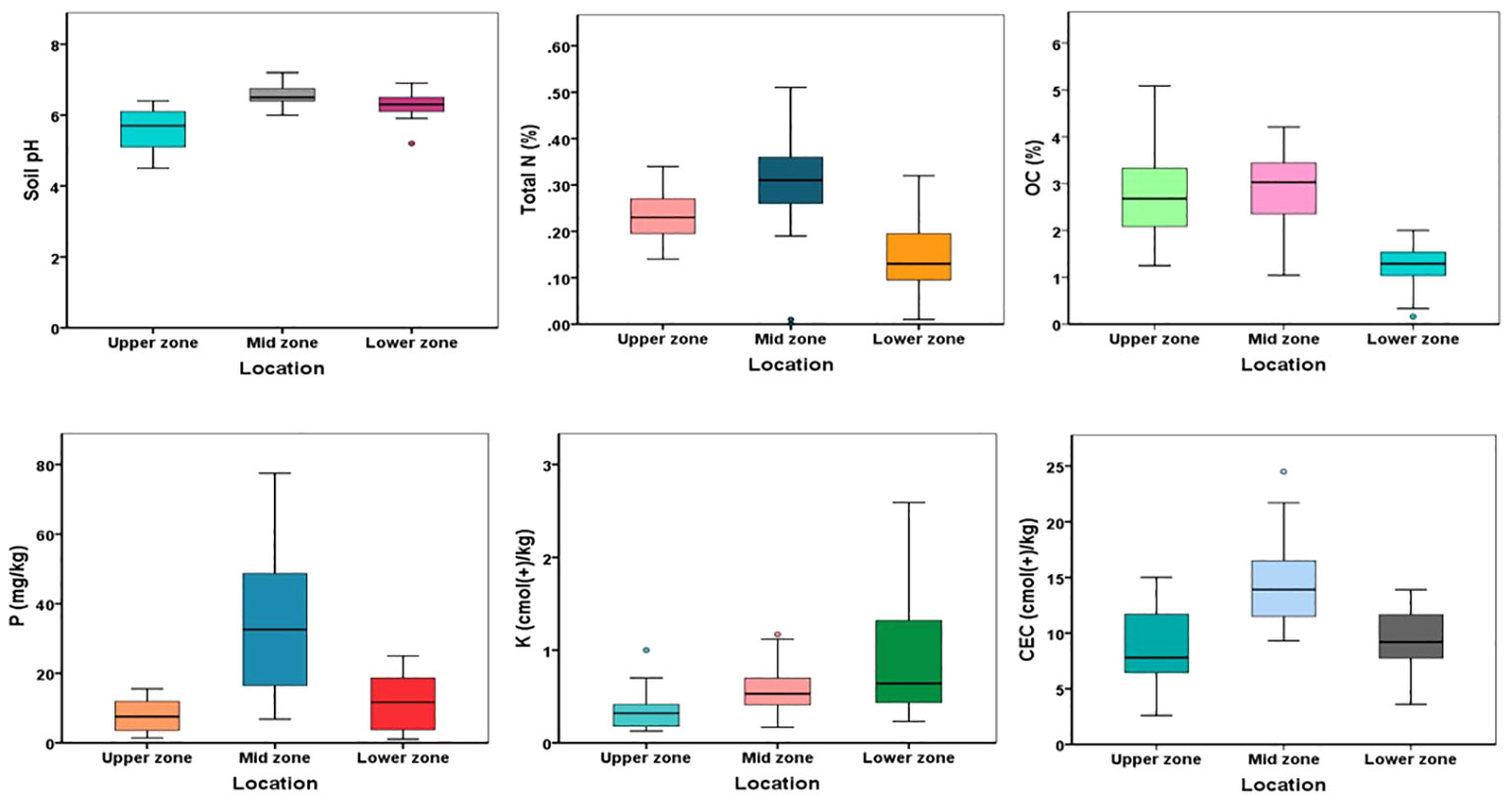
Figure 6 Box and whisker plot for soil properties along elevation gradient on southern slopes of Mount Kilimanjaro in Hai district Tanzania. NB: The upper zone (above 1400m.a.s.l); the mid zone (1000-1400 m.a.s.l); and the lower zone (below 1000 m.a.s.l).
4 Discussion
4.1 Engagement of socio-demographics in agriculture
The findings of this study revealed that most of the surveyed households were headed by men with an average farm size of 1.5 acres (0.6 ha). However, the few women who headed households were either due to divorce or their spouses were deceased. This implies that agricultural production in the study area is constrained by high pressure on the available land and the limited access of women to land ownership. Earlier studies in Tanzania and elsewhere in Africa, e.g., Mbilinyi (1986), FAO (1985), Shoo (2011), and Gebresamuel et al. (2021), indicate that both men and women participate fairly in agricultural production, with women handling most of the weeding, harvesting, and transportation, constituting up to 85% of the labor in agricultural activities. Therefore, in order to speed up the transformation of the agriculture sector to produce more food to attain the United Nations Sustainable Goals (SDs) 1 (no poverty), 2 (zero hunger), and 13 (climate action), special focus should be given to reviewing national policy to allow equal access for women to the available land. In addition, the findings of this study further revealed that most of agricultural activities in the study areas are performed by elders (>60 years old). This observation in agreement with the report by Naamwintome & Bagson (2013) in Ghana and Eboh (2022) in Nigeria. Less involvement of youth in agricultural production could be attributed to poor returns on labor inputs due to small farm sizes caused by gradual land fragmentation (Mammo, 2014). According to Ahaibwe et al. (2013), a lot of young people are giving up on agriculture because they believe it is only for individuals with low levels of education and nothing better to do. This is especially true for those who have completed at least secondary school. As a result, most youth migrate to the nearby cities and town in search of other easily payable off-farm occupations. All parties involved in agriculture should take note of these observations and use them as a wake-up call to develop plans for furthering the industry’s improvement.
4.2 Crop-livestock production and management
Banana and coffee were the major crops in high- and midland zones of the southern slope of Mt. Kilimanjaro. Banana (as a food and crop) and coffee (as a cash crop) are combined with trees and livestock in traditional farming systems (Ichinose et al., 2019). Historically, coffee was the most important cash crop on the slopes of Mt. Kilimanjaro (Maghimbi, 2007; Misana, 2019). Recently, most farmers have abandoned coffee production in their home gardens and instead concentrated on bananas and some annual crops, including vegetables, beans, and maize. Coffee production is neglected due to labor-intensive conditions and low produce prices (Mbonile et al., 2003; Kimaro & Bogner, 2019). The preference for banana over coffee is based on the crop’s dual value because it is used as food for family consumption and important source of household income (Meya et al., 2020). In contrast, the dominant crops in the lowland zone were maize and common bean; other crops such as sunflower, sesame, and tomato were also included in some fields. This result is in line with Misana et al. (2012) who reported that the major crops in the lowland areas of the slope of Mt. Kilimanjaro are maize and legumes (beans, cowpeas). Maize and common bean in the lowlands is mainly grown to supplement food and fodder in the highlands (Misana et al., 2012). Lowland areas are regarded as less fertile land with frequent droughts (Munishi et al., 2015). As a result, the lower plains of the mountain became characterized by mono- and inter-cropping farming systems dominated by cereal crops such as maize and rice, with rice dominating in river flood plains (Maghimbi, 2007). Few shrubs and scattered trees can be found in the lower plains.
The major livestock kept in most of the households in the area are dairy cattle and poultry with a few households keeping either goats or sheep. Dairy cattle are kept mainly for manure production as source of nutrients in their banana-coffee home gardens as well as for milk production. In this view, dairy cattle are regarded as nutrient concentrators and transporters from grasses and maize stover grown in surrounding and lowland fields to the banana-coffee home gardens (Ichinose et al., 2019). The findings of this study further revealed that the majority of smallholder farmers in the highland areas of Hai district manage their banana-coffee home gardens using animal manure collected from livestock herds. This observation confirms the report by Soini (2006), who reported that about 96% of smallholder farmers in the highland zones of Mt. Kilimanjaro use animal manure to manage their banana fields. However, some farmers use inorganic fertilizers only if the banana field is intercropped with vegetables and/or maize as reported earlier by Meya et al. (2020). Although manures are not enough due to the small number of animals kept by farmers in the highlands, nevertheless, at least each visited banana-coffee home garden received animal manure in a year. The situation is opposite in the lowlands, where farmers use only inorganic nitrogen fertilizer (if any, and mostly applied below recommended rate of 50 kg N ha-1) derived from Urea, CAN, and SA. The limited usage of manure and inorganic fertilizers observed in the research area is mostly due to shortage of animal manure and the high cost of inorganic fertilizers perceived by most of the visited farmers.
4.3 Challenges for soil fertility management in the study area
Smallholder farmers described various constraints they faced in managing soil fertility on their farmlands. High cost of inorganic fertilizers, shortage of animal manure and labor to apply, inadequate extension services, and soil erosion, are among the most frequently mentioned obstacles in the study area. Soini (2006) observed that one of the most common challenges confronting smallholder farmers in managing crop fields on the slopes of Mt. Kilimanjaro is a shortage of capital for farm inputs like fertilizers and manure. Soil fertility problems in smallholder fields may differ from place to place depending on the farming systems and management practices, however, the common obstacle for all smallholdings is low income, which eventually activates the accompanying limits (Giller et al., 2021; Mng’ong’o et al., 2021). In light of this, soil fertility management in smallholdings tends to vary with different socioeconomic classes. For example, studies on soil fertility management in smallholdings have indicated that wealthy farmers usually have access to many opportunities regarding soil fertility management, including access to extension services and farm inputs (fertilizers and improved seeds) on their fields, compared to poor farmers (Mucheru-Muna et al., 2021; Chivenge et al., 2022; Fanjaniaina et al., 2022).
4.4 Soil fertility status and management
The findings of this study demonstrated low soil pH in the upper zone and optimal in the mid and lower zones. The values of soil pH were categorized as moderately acidic in the upper zone and slightly acidic in the mid and lower zones (Hazelton and Murphy, 2019; Horneck et al., 2011; Motsara & Roy, 2008). The low value of soil pH recorded in the upper zone can be linked to high precipitation, which resulted in the washing away of exchangeable cations. Soil pH accounts for the potential availability of most essential plant nutrients (Amuri et al., 2017). Most plant nutrients become available at a pH range of 6.5–7.5 (Motsara & Roy, 2008). However, the optimal soil pH range for many plants is 6.0–7.0. Based on this observation, the highland zone requires some attention to correct the acidic level in the soil. Moreover, the result is consistent with the findings of Mathew et al. (2016), who reported low pH at high elevation (>1400 m.a.s.l.) of Mount Kilimanjaro. According to Hazelton and Murphy (2019), total N was optimal in the highland and midland zones, but deficient in the lowland zone. The observed optimal total N in the soils of upper and mid zones could be attributed to manure application. On the other hand, the low total N value observed in lowland farms can be due to the continuous depletion of soil organic matter and poor nutrient replenishment because crop products and residues are taken for food and fodder supplementation in highland areas during crop harvest as well as the subsequence animal grazing in the (Meya et al., 2020).
The values of OC were low (<1.8%) in the lowland zone and high (>1.8%) in the mid- and highland zones based on the categorization of Hazelton and Murphy (2019). This observation is attributed to the climatic conditions of the highland and midland zones and the continuous application of farmyard manure to the home garden fields. Hazelton and Murphy (2019) pointed out that the content of OC in soil is highly dependent on the climate and management practices. Soil carbon values are often lower in drier and hotter (high organic matter decomposition rate) areas than in wetter, colder (low organic matter decomposition) areas, and this confirms the varying weather on the slopes of Mt. Kilimanjaro. The CEC and extractable P were low in the soils of the highland and lowland zones and high in the midland soil zone (Hazelton and Murphy, 2019; Horneck et al., 2011). The low level of CEC recorded in the study areas can be explained by high precipitation, which exacerbated the washing away of exchangeable cations (Aprile & Lorandi, 2012). Nonetheless, the low CEC in the lowlands could be attributed to soil erosion and a little or lack of organic matter as a result of crop residual removal living the land with no organic residues. Within the research locations, there was also notable variability in the soil properties (Figure 6). The values of the soil parameters (pH, OC, N, P, K, and CEC) varied greatly throughout the locations. The variations in the management approaches used by smallholder farmers may be the cause of the observed heterogeneity within the site.
4.5 Soil nutrients association in the study site
The correlation matrix of relationships between soil pH and soil nutrients, as well as among the soil nutrients in the study area, was also observed. The findings from this study revealed that soil pH had a positive correlation with CEC and P in the high zone but positively associated with K and CEC in the mid zone. However, in the lowland zone the soil pH negatively related with total N. Furthermore, the soil pH negatively but not significantly correlated with OC in all zones. Findings, e.g., by Wibowo & Kasno (2021); Bi et al. (2018); and Zhou et al. (2019), revealed a negative and significant relationship between soil pH and OC, similarly to the present study. This indicates that a low pH promotes the formation of organic matter. Evidence from research findings revealed that the relationship between soil pH and soil nutrients varied greatly from one study to another. Studies e.g., by Zhao et al. (2011) and Kozak et al. (2005) reported a positive and significant correlation between soil pH and K+ but observed a negative association between soil pH and extractable P, while Hussain et al. (2022) observed a positive correlation between soil pH and P, similarly to the present study particularly in the high zone. In addition, a study by Bi et al. (2018) reported a negative association between soil pH and total N which is in line with the present study in the lowland zone. However, other studies e.g., by Kozak et al. (2005) observed a positive association between soil N and pH. The disagreement among the observed results could be explained by variations in soil qualities from one place to another. In order to draw a reliable conclusion about how nutrients interact with one another, more research in the subject of soil-nutrient interaction is required.
5 Conclusion
The purpose of this study was to compare the soil fertility management of two contract farming systems: the banana-based system of the highlands and maize-based system of the lowlands. The study found that most farming operations on the southern slopes of Mt. Kilimanjaro are performed by adults (41–60 years old) and the elderly (>60 years old), with the latter being the predominant group. The most frequently mentioned limitations in soil fertility management were the high utilization cost of inorganic fertilizers and limited accessible quantities of animal manure. The majority of participants appreciate the presence of extension services, particularly veterinary services, but little focus has been placed on agronomy extension services, which lead to poor soil fertility, especially in lowland areas. It is therefore, high time for policymakers in the country to focus on making agriculture an appealing sector to youth by: (i) improving agricultural produce market systems; (ii) improving financial resources and subsidies to attract more youth to engage in agriculture; (iii) providing training on how to professionally engage in agriculture through competent agriculture extension service providers; and (iii) most importantly, improving land ownership for youth as a way of promoting them to participate in agriculture.
Moreover, the average soil nutrient contents in the study site varied significantly with elevation, with the lowland zone soils having the lowest levels of most soil chemical properties like N, OC, P, and CEC. Much effort on soil fertility management, such as the use of animal manure, agroforestry practices, and soil erosion control measures like terracing and the use of grass strips and stones in the banana farming systems, has been observed in the study area. This was contrary to the maize farming systems in the lowlands, where the land is left with little vegetation cover and excessive grazing by nomadic cattle herds. The scenario has exposed the land to soil erosion agents, which could explain the low soil fertility observed in maize-based fields in the lowlands. Consequently, the research findings should be disseminated to policy makers and the intended farmers community, particularly in soil fertility management, with the goal of (i) advising farmers on the importance of soil nutrient replenishment, such as appropriate use of inorganic fertilizers, and (ii) encouraging farmers to manage and use accessible soil amendments such as animal manure and other soil management practices such as agroforestry and green manure in order to improve soil fertility. Furthermore, the issue of free-grazing on the remaining crop residues in the lowlands should be handled seriously, particularly by policymakers, in order to manage the land for long-term sustainability.
Data availability statement
The raw data supporting the conclusions of this article will be made available by the authors, without undue reservation.
Ethics statement
Ethical review and approval was not required for the study on human participants in accordance with the local legislation and institutional requirements. Written informed consent from the participants was not required to participate in this study in accordance with the national legislation and the institutional requirements.
Author contributions
LM: Conceptualization, Formal analysis, Investigation, Methodology, Software, Writing – original draft. AM: Writing – review & editing. NA: Writing – review & editing. PN: Project administration, Validation, Conceptualization, Methodology, Writing – review & editing. KM: Conceptualization, Funding acquisition, Project administration, Resources, Validation, Visualization, Writing – review & editing. KN: Funding acquisition, Resources, Visualization, Writing – review & editing.
Funding
The author(s) declare that financial support was received for the research, authorship, and/or publication of this article. The work received partial funding for research activities form VLIR-UOS project at the Nelson Mandela African Institution of Science and Technology, Tanzania.
Acknowledgments
The authors are appreciative to the Nelson Mandela African Institution of Science and Technology’s VLIR-UOS project for assisting with the development of this manuscript. Furthermore, we would like to thank the farmers, village leaders, and extension personnel of Hai district, where the study was carried out, for their assistance during the field survey and soil sampling. We wish to extend our gratitude to Nelson Mpumi for his technical support, especially the statistical analysis of this manuscript.
Conflict of interest
The authors declare that the research was conducted in the absence of any commercial or financial relationships that could be construed as a potential conflict of interest.
Publisher’s note
All claims expressed in this article are solely those of the authors and do not necessarily represent those of their affiliated organizations, or those of the publisher, the editors and the reviewers. Any product that may be evaluated in this article, or claim that may be made by its manufacturer, is not guaranteed or endorsed by the publisher.
References
Adamtey N., Musyoka M. W., Zundel C., Cobo J. G., Karanja E., Fiaboe K. K. M., et al. (2016). Productivity, profitability and partial nutrient balance in maize-based conventional and organic farming systems in kenya. Agric. Ecosyst. Environ. 235, 61–79. doi: 10.1016/j.agee.2016.10.001
Ahaibwe G., Mbowa S., Lwanga M. M. (2013). Youth engagement in agriculture in Uganda: challenges and prospects (Kampala, Uganda: Economic policy research center, Makerere University Campus). Available at: africaportal.org (Accessed January 18, 2024).
Amuri N. A., Mhoro L., Mwasyika T., Semu E. (2017). Potential of soil fertility management to improve essential mineral nutrient concentrations in vegetables in Dodoma and kilombero, Tanzania. J. Agric. Chem. Environ. 6 (02), 105. doi: 10.4236/jacen.2017.62007
Aprile F., Lorandi R. (2012). Evaluation of cation exchange capacity (CEC) in tropical soils using four different analytical methods. J. Agric. Sci. 4 (6), 278. doi: 10.5539/jas.v4n6p278
Bahilu B., Abebayehu A., Tadesse M., Bayu D. (2016). The effect of land management practices on soil physical and chemical properties in Gojeb Sub-river Basin of Dedo District, Southwest Ethiopia. J. Soil Sci. Environ. Manage. 7 (10), 154–165. doi: 10.5897/jssem2016.0574
Baijukya F. P., De Ridder N., Masuki K. F., Giller K. E. (2005). Dynamics of banana-based farming systems in Bukoba district, Tanzania: changes in land use, cropping and cattle keeping. Agriculture Ecosyst. Environ. 106 (4), 395–406. doi: 10.1016/j.agee.2004.08.010
Bi X., Li B., Nan B., Fan Y., Fu Q., Zhang X. (2018). Characteristics of soil organic carbon and total nitrogen under various grassland types along a transect in a mountain-basin system in Xinjiang, China. J. Arid Land 10, 612–627. doi: 10.1007/s40333-018-0006-1
Bray R. H., Kurtz L. T. (1945). Determination of total, organic, and available forms of phosphorus in soils. Soil Sci. 59 (1), pp.39–pp.46. doi: 10.1097/00010694-194501000-00006
Bremner J. M., Mulvaney C. S. (1982). “Chemical and microbiological properties,” in Methods of soil analysis. Part II (Madison, Wisconsin: American Society of Agronomy: Soil Science Society of America), 595–624.
Chapman H. D. (1965). “Cation-exchange capacity,” in Methods of soil analysis: Part 2 Chemical and microbiological properties, (USA: ASA, CSSA, SSSA (Agronomy monographs)). vol. 9, 891–901.
Chivenge P., Zingore S., Ezui K. S., Njoroge S., Bunquin M. A., Dobermann A., et al. (2022). Progress in research on site-specific nutrient management for smallholder farmers in sub-Saharan Africa. Field Crops Res. 281, 108503. doi: 10.1016/j.fcr.2022.108503
De Bauw P., Van Asten P., Jassogne L., Merckx R. (2016). Soil fertility gradients and production constraints for coffee and banana on volcanic mountain slopes in the East African Rift: A case study of Mt. Elgon. Agriculture Ecosyst. Environ. 231, 166–175. doi: 10.1016/j.agee.2016.06.036
De Koning G. H. J., Van de Kop P. J., Fresco L. O. (1997). Estimates of sub-national nutrient balances as sustainability indicators for agro-ecosystems in Ecuador. Agriculture Ecosyst. Environ. 65 (2), 127–139. doi: 10.1016/S0167-8809(97)00059-5
Eboh E. (2022). Youth Employment and Wealth Creation through Agricultural Entrepreneurship: The Delta State Model as Evidential Case for Paradigm Shift. (Nigeria: The 7th Agricultural Policy Stakeholders’ Forum and International Conference).
Fanjaniaina M. L., Stark F., Ramarovahoaka N. P., Rakotoharinaivo J. F., Rafolisy T., Salgado P., et al. (2022). Nutrient flows and balances in mixed farming systems in Madagascar. Sustainability 14 (2), p.984. doi: 10.3390/su14020984
FAO (1985). Women in agricultural production human resources (Institutions and Agrarian Reform Division, Rome Food and Agriculture Organization).
Gebresamuel G., Opazo-Salazar D., Corral-Nunez G., van Beek C., Elias E., Okolo C. C. (2021). Nutrient balance of farming systems in Tigray, northern Ethiopia. J. Soil Sci. Plant Nutr. 21, 315–328. doi: 10.1007/s42729-020-00362-3
Giller K. E., Delaune T., Silva J. V., van Wijk M., Hammond J., Descheemaeker K., et al. (2021). Small farms and development in sub-Saharan Africa: Farming for food, for income or for lack of better options? Food Secur. 13 (6), 1431–1454. doi: 10.1007/s12571-021-01209-0
Hazelton P., Murphy B. (2019). Interpreting soil test results: What do all the numbers mean? (CSIRO publishing). doi: 10.1071/9781486303977
Horneck D. A., Sullivan D. M., Owen J. S., Hart J. M. (2011). Soil test interpretation guide (Oregon State University, Extension Service), 12.
Hussain A., Chen L., Jamil M. A., Abid K., Khan K., Duan W., et al. (2022). Changes in soil-phosphorus fractions by nitrogen and phosphorus fertilization in Korean pine plantation and its natural forest. Forests 13 (4), 527. doi: 10.3390/f13040527
Ichinose Y., Nishigaki T., Kilasara M., Funakawa S. (2019). Central roles of livestock and land-use in soil fertility of traditional home-gardens on Mount Kilimanjaro. Agroforestry Syst. 94, 1–14. doi: 10.1007/s10457-019-00357-9
Kaihura F. B. S., Stocking M., Kahembe E. (2001). “Soil management and agrodiversity: a case study from arumeru, arusha, tanzania,” in Proceedings of the symposium on managing biodiversity in agricultural systems, 14.
Kangalawe R. Y., Noe C., Tungaraza F. S., Naimani G., Mlele M. (2014). Understanding of traditional knowledge and indigenous institutions on sustainable land management in Kilimanjaro Region, Tanzania. Open J. Soil Sci. 4 (13), 469. doi: 10.4236/ojss.2014.413046
Kimaro J., Bogner C. (2019). Water management under traditional farming systems: practices and limitations of the Mfongo system around Mt. Kilimanjaro. Water Utility J. 22, 53–64.
Koning N., Smaling E. (2005). Environmental crisis or ‘lie of the land’? The debate on soil degradation in Africa. Land Use Policy 22 (1), 3–11. doi: 10.1016/j.landusepol.2003.08.003
Kozak M., Stêpieñ M., Joarder A. H. (2005). Relationships between available and exchangeable potassium content and other soil properties. Polish J. Soil Sci. 38 (2), 179–186.
Laekemariam F., Kibret K., Shiferaw H. (2018). Potassium (K)-to-magnesium (Mg) ratio, its spatial variability and implications to potential Mg-induced K deficiency in Nitisols of Southern Ethiopia. Agric. Food Secur. 7 (1), 1–10. doi: 10.1186/s40066-018-0165-5
Lauderdale S. (2005). Book Review: Biostatistics: A Methodology for the Health Sciences. 2nd Edition Vol. 39. Eds. Belle G. V., Fisher L. D., Heagerty P. J., Lumley T. (Hoboken, NJ: John Wiley & Sons), 871 pp. In Annals of Pharmacotherapy. doi: 10.1345/aph.1E470
Lema A. A., Munishi L. K., Ndakidemi P. A. (2014). Assessing vulnerability of food availability to climate change in Hai district, Kilimanjaro region, Tanzania. Am. J. Climate Change 03 (03), 261–271. doi: 10.4236/ajcc.2014.33025
Maghimbi S. (2007). Recent changes in crop patterns in the Kilimanjaro region of Tanzania: the decline of coffee and the rise of maize and rice. Afr. study Monogr. 35, 73–83. doi: 10.14989/68490
Mathew M. M., Majule A. E., Marchant R., Sinclair F. (2016). Variability of soil micronutrients concentration along the slopes of Mount Kilimanjaro, Tanzania. Appl. Environ. Soil Science. 2016, 7. doi: 10.1155/2016/9814316
Mbonile M., Misana S., Sokoni C. (2003). Land use change patterns and root causes on the southern slopes of Mountain Kilimanjaro, Tanzania. Land Use Change impacts dynamics (LUCID). working paper 25.
McLean E. (1983). “Soil pH and lime requirement,” in Methods of soil analysis: Part 2. Chemical and Microbiological Properties, (USA: ASA, CSSA, SSSA (Agronomy monographs)). vol. 9. , 199–224.
Mesfin S., Gebresamuel G., Zenebe A., Haile M. (2021). Nutrient balances in smallholder farms in northern Ethiopia. Soil Use Manage. 37 (3), 468–478. doi: 10.1111/sum.12635
Meya A. I., Ndakidemi A., Mtei K. M., R. and Merckx R. (2020). Optimizing soil fertility management strategies to enhance banana production in volcanic soils of the Northern Highlands, Tanzania. Agronomy 10 (2), p.289. doi: 10.3390/agronomy10020289
Mhoro L., Meya A. I., Amuri N. A., Ndakidemi P. A., Mtei K. M., Njau K. N. (2023). In fl uence of farmers ’ socio- economic characteristics on nutrient fl ow and implications for system sustainability in smallholdings : a review. Front. Soil Sci. 3. doi: 10.3389/fsoil.2023.1112629
Misana S. (2019). Linkages between changes in land use, biodiversity and land degradation on linkages between changes in land use, biodiversity and land degradation on the slopes of mount kilimanjaro, tanzania.
Misana S. B., Sokoni C., Mbonile M. J. (2012). Land-use/cover changes and their drivers on the slopes of Mount Kilimanjaro, Tanzania. J. Geogr. Regional Plann. 5 (8), 151. doi: 10.5897/JGRP11.050
Mng’ong’o M., Munishi L. K., Blake W., Comber S., Hutchinson T. H., Ndakidemi P. A. (2021). Soil fertility and land sustainability in Usangu Basin-Tanzania. Heliyon 7 (8), e07745. doi: 10.1016/j.heliyon.2021.e07745
Motsara M. R., Roy R. N. (2008). Guide to laboratory establishment for plant nutrient analysis (19): Food and Agriculture Organization of the United Nations Rome. FAO Viale delle Terme di Caracalla 153, 204.
Mucheru-Muna M. W., Ada M. A., Mugwe J. N., Mairura F. S., Mugi-Ngenga E., Zingore S., et al. (2021). Socio-economic predictors, soil fertility knowledge domains and strategies for sustainable maize intensification in Embu County, Kenya. Heliyon 7 (2), 1–15. doi: 10.1016/j.heliyon.2021.e06345
Munishi L. K., Lema A. A., Ndakidemi P. A. (2015). Decline in maize and beans production in the face of climate change at Hai District in Kilimanjaro Region, Tanzania. Int. J. Climate Change Strategies Manage. 7 (1), 17–26. doi: 10.1108/IJCCSM-07-2013-0094
Nelson D. W., Sommers L. E. (1996). “Total carbon, organic carbon, and organic matter,” in Methods of soil analysis: Part 3 Chemical methods, (USA: ASA, CSSA, SSSA (Agronomy monographs)) vol. 5, 961–1010.
Pržulj N., Tunguz V., Jovović Z., Velimirović A. (2022). The signif icance of harvest residues in the sustainable management of arable land. ii. harvest residues management. Arch. Tech. Sci. 27 (1), 49–56. doi: 10.7251/afts.2022.1427.049P
Shoo T. A. (2011). Gender division of labour in food production and decision-making power and impact on household food security and child nutrition in rural Rukwa, Tanzania. (Norway: Department of Community Medicine, Institute of Health and Society University of Oslo), 100. Thesis submitted in partial fulfilment of Master of Philosophy degree in International Community Health.
United republic of Tanzania (URT). (2017). Kilimanjaro region investment guide. (The United Republic of Tanzania: The President’s office Regional and Administration and Local Government), 88.
Van Loon M. P., Deng N., Grassini P., Edreira J. I. R., Wolde-Meskel E., Baijukya F., et al. (2018). Prospect for increasing grain legume crop production in East Africa. Eur. J. Agron. 101, 140–148. doi: 10.1016/j.eja.2018.09.004
Wibowo H., Kasno A. (2021). “Soil organic carbon and total nitrogen dynamics in paddy soils on the Java Island, Indonesia,” in 1st International Conference on Sustainable Tropical Land Management: Earth and Environmental Science (IOP Publishing) 648, 012192. doi: 10.1088/1755-1315/648/1/012192
Zhao J., Dong Y., Xie X., Li X., Zhang X., Shen X. (2011). Effect of annual variation in soil pH on available soil nutrients in pear orchards. Acta Ecologica Sin. 31 (4), 212–216. doi: 10.1016/j.chnaes.2011.04.001
[ad_2]


